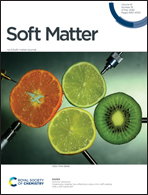A theoretical phase diagram for an active nematic on a spherical surface
Abstract
Systems combining rod-shaped objects with self-generated motion such as suspensions of microtubules or growing bacterial colonies are commonly modeled as active nematics – nematic liquid crystals with an additional active stress term. Confining a 2D active nematic to the surface of a sphere generates novel behaviour as the four +1/2 nematic defects which are produced by the spherical geometry move round each other in an intricate dance. Here, these defects are modeled as point particles experiencing elastic forces from defect position and orientation, and self-propulsion due to activity. This model exhibits four qualitatively distinct types of trajectory state: two which are consistent with previous experimental and simulated trajectories; and two others, which are apparently novel and in regions of parameter space that may not yet have been explored. This work also explains a discrepancy between some previous point-particle models and the trajectories seen in experiments and simulations: this was due to a failure to fully account for the spherical geometry in the point-particle models.



 Please wait while we load your content...
Please wait while we load your content...